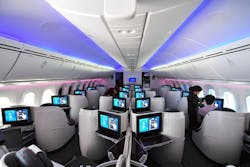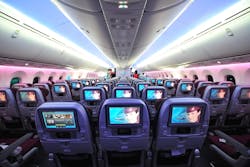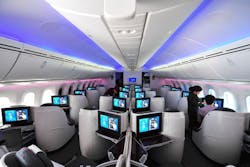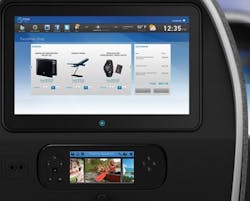Growing in-flight connectivity market holds great potential for satellite businesses
LONDON, 10 April 2015. The commercial aircraft connectivity market is expected to achieve retail revenues of $3.2 billion U.S. by 2024, with in-flight connectivity (IFC) FSS Ku-band and HTS installs on wide-body and narrow-body airplanes will driving market growth, according to NSR's Aeronautical Satcom Markets (Third Edition) report.
"Today's passengers expect IFC. It is no longer a 'luxury item' for their journey. Its place in the journey has become almost as expected as the emergency card in the seat pocket in front of them," explains Claude Rousseau, NSR research director and author of the report. "This expectation fuels airlines' investment projects in IFC. They see take-up rates of satcom and air-to-ground services grow faster, as more terminals are installed on aircrafts worldwide."
For the more than 100,000+ airframes in the addressable market, NSR projects that today's business is a fraction of the potential for satellite communications (SatCom) connectivity with only 47,500 in-service SatCom units deployed. As more satellite flavors are available to link aircraft with the ground for popular social media applications or bandwidth-hungry video applications, every indications points to a surge in capacity demand that could shake-up the market and extend connectivity to more airlines for both long and medium-haul.
"The past year as seen some airlines diversify satellite solutions to adapt services to the demand from passengers and crew alike on regional and trans-oceanic routes," Rousseau adds. “This has meant more bandwidth has been consumed in more aircrafts at cruising altitude to satisfy the growing base of passengers that want always-on connectivity, anywhere."
Building on passengers' thirst for connectivity, the market is expanding globally. The applications will reach further into the operations of aircraft fleets, and bring more safety during flight. Mostly an L-band market today, customer requirements are moving airlines to adopt more FSS Ku-band and GEO/Non-GEO HTS satellite bandwidth. By 2024, NSR forecasts the market for Aeronautical SATCOM connectivity will reach 160 transponder equivalents for FSS Capacity, and 81 Gbps of bandwidth across GEO/Non-GEO systems.
The ASM 3rd Edition study provides in-depth and detailed analysis and forecasts of aeronautical satellite demand for enterprise and commercial markets, as well as demand assessment of commercial and business aviation air-to-ground (ATG) aeronautical services and covers emerging High Throughput Satellite capacity in GEO (Ku-band and Ka-band) and non-GEO. It provides an assessment of in-flight connectivity take-up rates and pricing.
NSR, is an international market research and consulting firm with a core focus on the satellite sector and related industries, specializes in analysis of growth opportunities across four core sectors: Satellite Communications, Broadcasting & Digital Media, Hybrid & Emerging Applications, and Commercial Space.
In-flight connectivity images courtesy Shutterstock.



